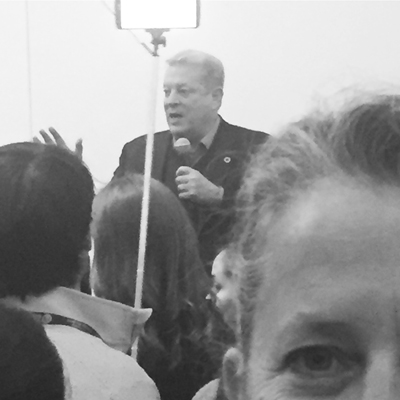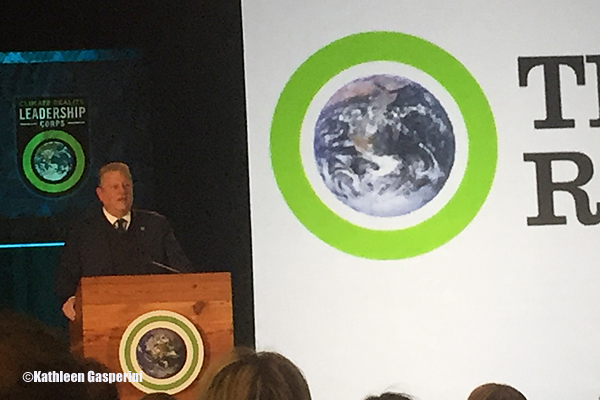
Former Vice President Al Gore trained me to become a certified Climate Reality Leader earlier this month in Denver, CO, and it was one of those life-changing experiences that spawned new energy, ideas, and set the course of my future actions. For the sake of this story, which will be one in a series, and my background in the snow sports, it’s even clearer to me now that what’s taking shape with the future of snow and the impact on outdoor recreation due to global climate change, calls for far more effective and faster action. As Mr. Gore put it, “The stakes have never been higher.”
To set the stage of the Climate Reality Leadership Corps, absolutely everybody who got accepted had a sense of urgency within their own worlds about the climate crisis. For me, it was with initial disbelief, and later, with honor, to realize that I had been selected among thousands of applicants from around the world to be one of the 972 people chosen from 32 different countries to participate in this training.
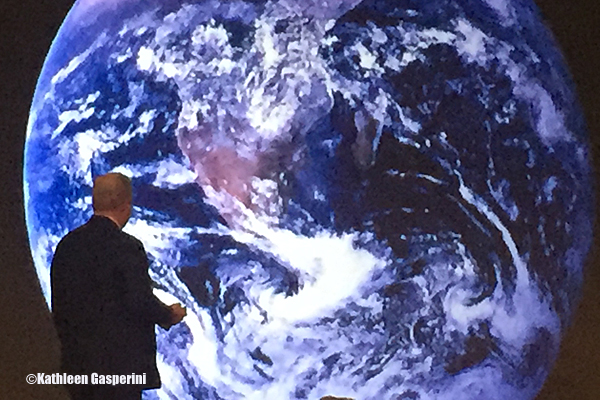
This was more than the showing of a Mr. Gore’s award-winning documentary “An Inconvenient Truth” or a plug for the sequel “An Inconvenient Sequel: Truth to Power” (which I am doing instead, as it will be released July 28-29, 2017, from which earnings will go to the Climate Reality Project). Former Vice President Al Gore presented 3-4 times a day, moderated panel discussions, hosted an evening meet and greet, and truly was the trainer and the man behind the action. Before anyone asks, no, we did not pay to be trained. If you got in, it was free. The Climate Reality Project was started by Al Gore in 2011 and funded by his 501(c)3 non-profit. He pays. The training included the world’s freshest data and resources from the top scientists around the world. It included presentations that Mr. Gore was constantly updating, even throughout the training.
As Mr. Gore stated in his opening comments, he was gravely concerned about the new administration’s fossil fuel agenda, and the policies that were being eroded from protecting our energy future and ending the climate crisis. We were the 34th Climate Reality Leadership Corps training he had done, but “the first since the new administration had taken place.”
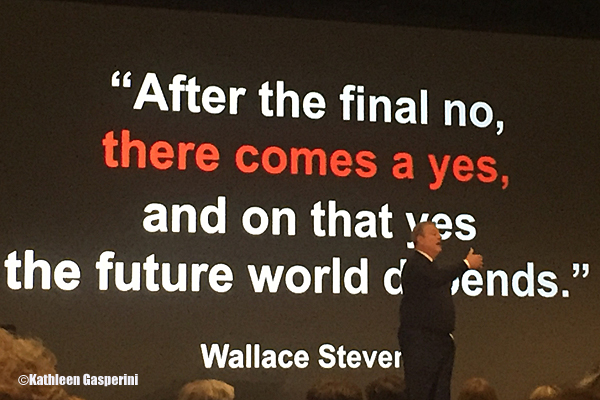
The burden was palpable as the audience went silent at the prospect of this responsibility. Once we became Climate Reality Leaders, we were to take what we learned and spread the message to others through our writing, activism, presentations, connections, and communities. We were chosen based on our diversity and what we had achieved so far, and committed to do so in the future. The screening process must have been intense, as there were clearly all ethnicities represented, religions, age groups, economic differences. My first day I had coffee with a fellow attendee–the Communications Director for the President of Indonesia. At lunch I met a farmer from the Midwest worried about commercial agriculture. My partner (they pair you with different people) was from Pakistan and started a program to educate 1 million young people in her country about the climate crisis by 2020.
Starting with the Horror: The training starts with an intense presentation by Mr. Gore that shows you the reality of what is happening to our planet. You see that the layer protecting the earth from the cosmic atmosphere that can kill all life on earth, is as “thin as a coat of varnish on a wooden table.” From a snow industry perspective, for the case of this first story, the cold hard facts are that:
1) Poor snow years have increased 22% in the Northeast
2) Colorado snow melts 2 weeks earlier than in the 1970’s
3) The Sierra Nevada Mountains could get 50% less snow by 2050
4) The decade 2001-2010 was the warmest in the instrumental record dating back to the 1880’s
This is just a drop in the bucket: What’s shaped our policies globally have much to do with global climate change, including the increase in climate refugees, food shortages, for example, that lead to the Syrian refugee crisis, the acidification of our oceans and bleaching of our coral reefs. The C02 being released into the atmosphere is happening now faster than at any time in at least the last 66 million years. To put it another way: The energy trapped by man-made global warming pollution is now “the equivalent to exploding 400,000 Hiroshima atomic bombs per day 365 days per year.”

Ending with the Hope: After the first day, it was easy to lose hope. Yet, this training left me more hopeful than anything I’ve ever done, because as it progressed, there was more evidence that the tide was changing. OK, made not from a federal level, talk about the Trump administration did surface, but was not the main point at all. What could be done for the future in terms of advocacy will come from a state and local level, not to mention the fact that economically, it is becoming cheaper to use renewable energy solutions.
Ken Berlin, the Climate Reality Project CEO gave a most inspiring morning address on the second day as he pointed out time and time again, what was happening and the impact we could have on local and state levels towards a clean energy economy. Leah Greenberg co-author of the Google docs, “Indivisible: A Practical Guide for Resisting the Trump Agenda,” which has spawned 7,000 grassroots affiliates in 50 states, presented on what could be done to change the course of our political policies. Her presentation and what her group has down earned a standing ovation and a vow by the Climate Reality Leadership team to work together in the future. What’s happening is that there’s more civilian activation taking place across the country and the world than ever before. We don’t have to depend on the leadership at the federal level.
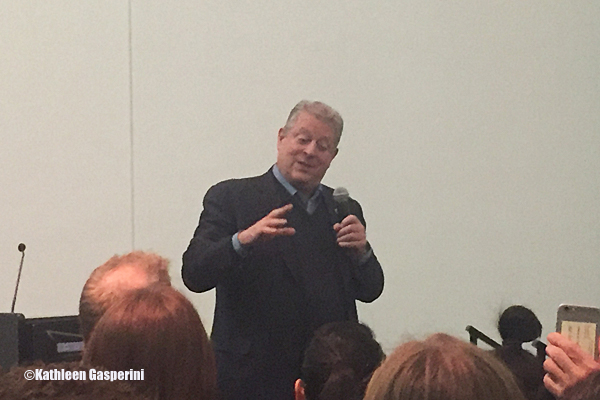
As for the most inspirational moments of hope, they came from Mr. Gore. He took us through the course of the suffragette movement and how hard and long it took women to get the right to vote. He highlighted the successes of the civil rights movement, the struggles for freedom during apartheid, the science behind the nuclear freeze movement, how the gay rights movement is charting a new course… He said, “Things take longer to happen than you think they would, and then they occur faster than you thought they could ever happen.”
This is what’s happening with the action around climate change.
One of the highlights of the training was when Mr. Gore awarded the “green ring” leaders for those making a tremendous impact on their communities. They included many people within the Climate Reality Project’s “I AM PRO SNOW” 100% Committed Campaign, for their work in getting certain mountain communities to commit to changing to 100% renewable energy by 2030. The I AM PRO SNOW team had commitments from Aspen, CO, Park City, UT, Moab, UT, and others, and had gotten three ski resorts in New York, including state-owned Belleayre Mountain Ski Center, Gore and Whiteface mountains to commit to 100% renewable energy by 2030!
For me, and others in the audience from the snow industry, while this is an amazing start, it begs the question, what about other ski resorts? Where were they in terms of their commitments to ending the climate crisis? NSAA (National Ski Areas Association) has programs for resorts to encourage sustainability such as Sustainable Slopes, but how accountable are they? It’s also interesting to note that the upcoming NSAA annual conference, being held in Arizona in May, 2017, doesn’t list one program on sustainability and global climate change and how resorts are addressing these issues. For a $7.6 billion industry in direct spending from ski resorts alone, according to their site, loss from such revenue due to global climate change, seems like it would be the leading topic of conversation.
Personally, having just come off completing an intense research project for Snow Industries of America (SIA) dealing with youth culture and snow sports, and completing Label Networks’ 5th Annual Sustainability and the State of Youth Culture Report with interviews of more than 40,000 13-25-year-old’s across the United States, we know how important sustainability and the global climate crisis is to the future of snow markets and youth culture in general. Even FIS’s application process for hosting World Cup events talks about sustainability. They have a pretty decent guideline for resorts to consider, but do the resorts have to abide? Can we see the sustainability reports after the FIS World Cup has come and gone? FIS states that they are “seeking experts” in this field, and so I emailed them. I am an expert in this field. I’m looking forward to hearing back.
While there were many things that sparked my passion and re-invigorated my quest to do what I can about the climate crisis from the training, I was passionately interested in promoting the cause of ski resorts moving to 100% renewables and taking the steps outlined in their I AM PRO SNOW’s 100% Renewable Campaign. I’m glad to report that progress has started, thanks to the blessing and guidance of the leaders from I AM PRO SNOW. Fortunately, I’m not the only one on this mission. (More news later.)
In the scheme of things, learning about what’s taking place around this world, including the hardships of displacement for climate refugees, wars, droughts, famines, and diseases that have been triggered, and then looking at the recreational snow industry, there’s just no comparison. I am fortunate to live in the United States, to have grown up in Upstate NY and learned to ski because my high school started a small club when I was in 8th grade that bused us to community resorts like Dry Hill, Snow Ridge, and the “big mountain” Whiteface. I was lucky that my mom volunteered as one of several chaperones so that my family could get a discounted ski club price for my sisters and brother.
In the face of what my new 972 colleagues and I just learned, we also learned that we each need to take a piece that resonates the most with us, and just get started there. If Belleayre Ski Center can commit to 100% renewable energy, why can’t Vail?
In the final day of training, I was feeling like I had the assets ready to march on in a direction for my own initiatives for sustainability. Everything before had led to this. I’d met hundreds of people from all walks of life and circumstances that I would never forget and continue to learn from. I was now one of 10,000 around the world who had completed the training from the world’s leading organization dedicated to mobilizing action around climate change. I have the tools–presented in an actionable package, a highly customizable presentation. If I have questions, I have access to a mentor, regional leaders in my area, global scientists, researchers, international leaders, and even Mr. Gore himself.
“Renewable hope needs a speedy transformation,” wrapped-up Mr. Gore in the final minutes of the training. In a loud, booming voice, you could feel his commitment and the true intentions of what he was doing. This was incredibly important. “The stakes are as high as they could be,” he said. “But the will to overcome, is itself, a renewable resource.”
